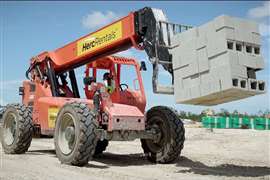Safer up high
09 May 2008
Tower crane safety has been a hot subject in the UK since a fatal accident in May 2000 on the Canary Wharf development in London. A luffing jib tower crane collapsed when a climbing frame was being used to insert mast sections. Three of the erection crew were killed.
That accident prompted the industry to examine its procedures and was the catalyst for reform, led by the Construction Plant-hire Association's Tower Crane Industry Group (TCIG) formed in the aftermath of the accident.
A brighter spotlight, however, was shone on the sector after a fatal collapse in September 2006 in Battersea, South London. One of the two men killed was a “civilian” – a member of the public – which turned a construction industry issue into a political one. Action groups were formed, petitions for better crane safety were drawn up and politicians took an interest.
Four months later was another fatal accident, in Liverpool, killing a site worker and injuring the operator. Due to the fact that both cranes were owned by the same company, some people in the industry may have chosen to believe that any systemic, procedural problems were restricted to that one company. With public attention now firmly on crane safety, however, more tower crane accidents made their way into the news, in some instances, involving companies reckoned to be among the best regarding safety. Five further accidents were reported during 2007, resulting in three injuries but no more fatalities.
Training and maintenance
While only the Canary Wharf collapse has led to publication of an official report by the government’s Health & Safety Executive – a catalogue of contributory factors rather than identifying a specific cause – the industry has learned the lessons of subsequent accidents and is attempting further reform. Key areas are training and maintenance.
Construction accident reporting statistics do not always immediately reveal what machine may have been involved. Categories include ’falls from height’ and ’struck by load’ which may or may not involve a crane. It appears, however, that recently there has been an increase in tower crane accidents. The explanation may be simple. The UK construction industry has rarely been busier. The tower crane population has grown fivefold in the last 10 years from around 500 to close to 2,500, including self erectors.
It has made competition fiercer then ever – always a potential inducement to cutting corners – and there has been a recruitment crisis. Access to university education in the UK has opened up widely in the last 20 years and graduates tend not aspire to operate, erect or maintain cranes. Recruitment in the construction industry is, increasingly, from Eastern European immigrants, whose knowledge of the English language is often limited, which in itself may have safety implications.
Even companies with a full workforce are likely to have a disproportionate number of new entrants with limited experience.
Industry training and certification schemes have developed since 2000 but all–important experience cannot be acquired so quickly. It is hard to imagine an experienced well–trained erection crew failing to insert climbing frame bolts, for example, which led to the collapse of a luffing jib crane in Croydon, south of London, in June 2007.
Inadequate maintenance procedures has been identified as a key factor in several of the recent accidents, either due to complacency, inexperienced workers or corner–cutting in the face of commercial pressures. In February 2006 the luffing jib brake failed on a 30–year–old tower crane on a site in Greenwich, east London. The contractor’s investigations revealed that the brake lining disintegrated in the drum, causing the jib to collapse. It was a totally preventable mechanical failure. The contractor discovered that “the service records for the machine were of an incredibly poor standard, some of the test records were incomplete and there were no tests carried out on site when the crane was erected.” Poor record keeping was also highlighted in the HSE report on the Canary Wharf accident.
Operators used to check the crane by walking the jib, perhaps daily. This is now largely prohibited for fear of falls. There is a statutory requirement for annual third party inspections (or six–monthly if the cranes are lifting people). It is usually done by insurance companies likely to lack specific expertise on that crane model. Interim inspections are also required, although the frequency and thoroughness of these varies between companies.
Taking notes
The Tower Crane Interest Group, which represents crane owners, has published a series of useful Technical Information Notes that can be downloaded for free (see note). TCIG has also helped develop training schemes for tower crane installation and operation, as part of a wider training programme. Construction Plant Competence Scheme cards for tower crane appointed persons, crane supervisors and slinger/signallers have also been introduced. There is not yet a CPCS category tower crane installation, although there are recognised training programmes.
Concern about the increase in accidents prompted the wider construction industry to take the initiative. The Strategic Forum for Construction, a construction industry body with a mission to improve the industry’s effectiveness and efficiency, set up a Tower Crane Group in August 2007. This group includes crane owners from the TCIG and their construction company clients, representatives from the insurance industry and safety professionals.
At its second meeting, in October, Strategic Forum Tower Crane Group set up seven sub–groups to produce new guidance on the following topics:Site inductions n Competency and training schemes n Maintenance and thorough examination Operator working conditions Communication on site Sharing information on near–miss incidents Communication with the public.
Of these, potentially the most significant is the work being done on maintenance and thorough examination. November saw a 94– page draft document, Maintenance and Thorough Examination of Tower Cranes: Best Practice Guide. During the two–month consultation period there was a broadly favourable response from about 100 comments that were received, says Tim Watson, consultant to the Construction Plant–hire Association who put the document together.
A final version is scheduled for publication in April 2008.
Alex Lowe, managing director of HTC, a leading UK tower crane rental company, says the new document is the most significant initiative to date. “I think it will be good. If people follow it, it will protect others and make the industry safer.”
So comprehensive is the guide, covering the management of records and auditing, plus conducting examinations and implementation of preventive maintenance, that anyone following it is likely to have to change their procedures. Watson explains: “A lot of people are doing a lot of good things but not everybody is doing everything. I’d be surprised if anyone found they didn’t have to change a thing.”
Watson adds, “The thing that the document emphasises is that maintenance and thorough examination are separate, but related, entities.”
The Construction Plant–hire Association’s TCIG has been instrumental in producing this guide and has continued to produce further crane guidance on its own initiative. In December it published the 59–page Best Practice Guide on Safe Use of Top Slew Tower Cranes, following up its earlier similar volume for self erectors. The guide for top slewing cranes includes 26 daily checks to be done before using the crane, plus 10 checks that should be made every week.
Next up, also for April publication, is a pocket book for operators. Another Technical Information Note is also in production, which will be the 21st in the series. It will cover out of service wind speeds.
Whether these best practice documents reduce accidents remains to be seen. “I think it will slowly have an impact,” Watson says. They may not prevent incidences of human error on site but, says Watson, accidents are often caused by the coming together of several factors, rather than a single error.
If crane owners and their customers take on board the procedures set out, it could minimise the impact of any mistakes on site.






